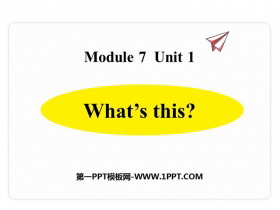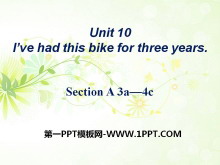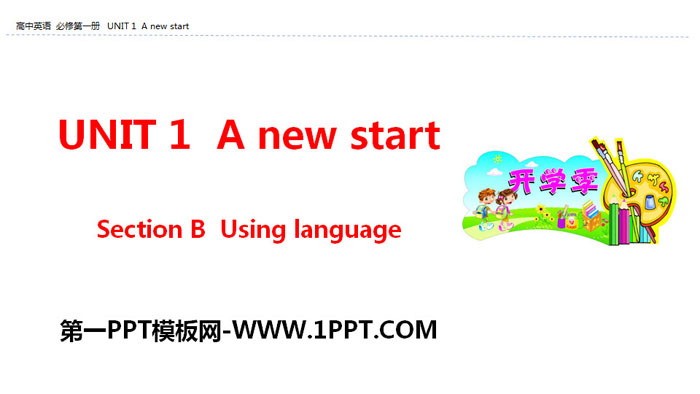
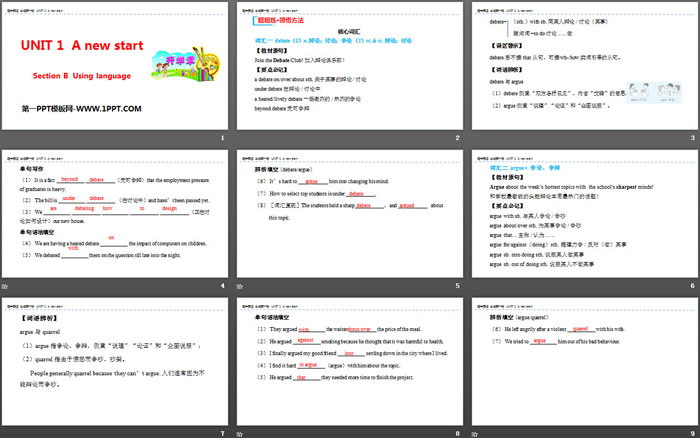
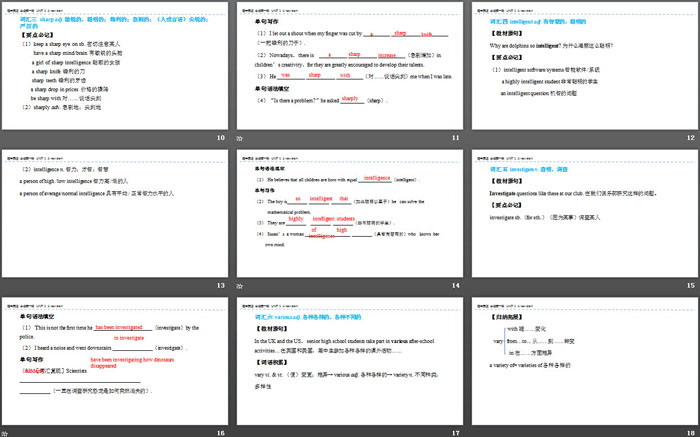
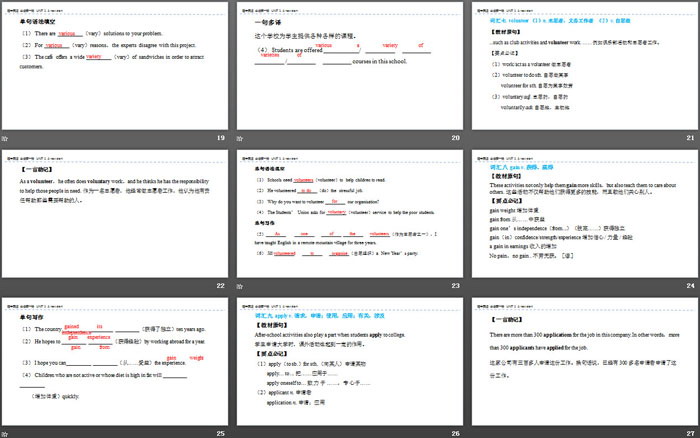
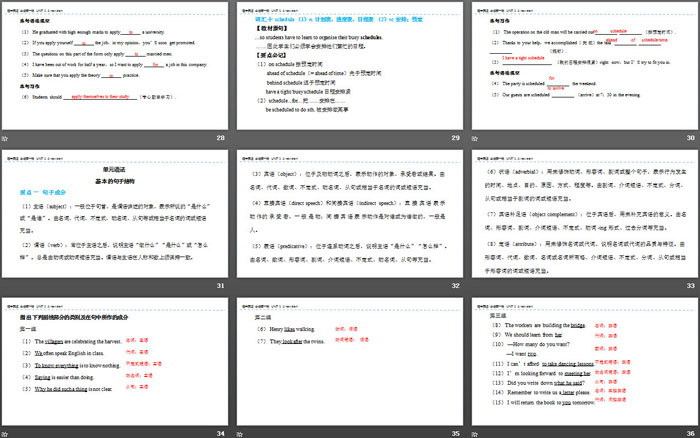
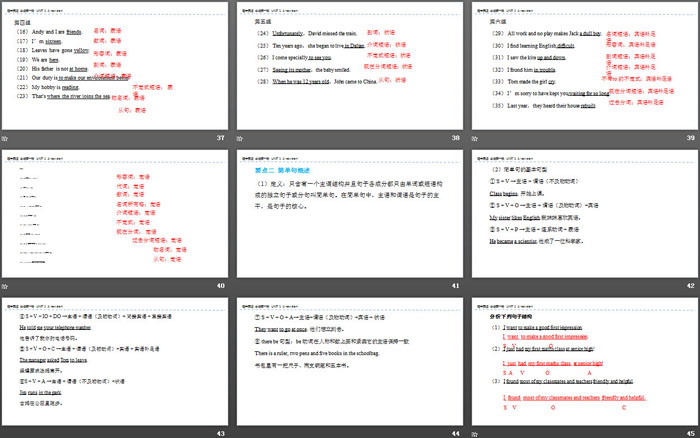
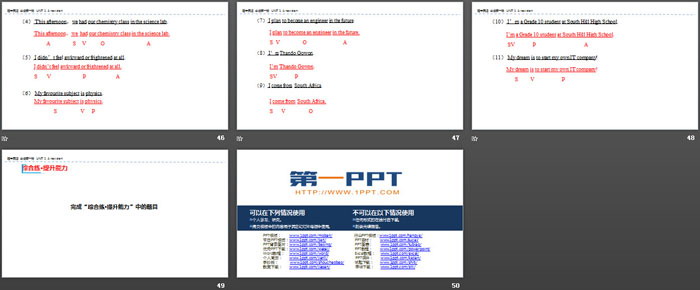
《A new start》Section B PPT
第一部分内容:题组练·领悟方法
核心词汇
词汇一 debate(1)n. 辩论;讨论;争论 (2)vt. & vi. 辩论;讨论
【教材原句】
Join the Debate Club! 加入辩论俱乐部!
【要点必记】
a debate on/over/about sth. 关于某事的辩论 / 讨论
under debate 在辩论 / 讨论中
a heated/lively debate 一场激烈的 / 热烈的争论
beyond debate 无可争辩
【误区警示】
debate 后不接 that 从句,可接 wh-/how 类词引导的从句。
【词语辨析】
debate 与 argue
(1)debate 侧重“双方各抒己见”,内含“交锋”的意思;
(2)argue 侧重“说理”“论证”和“企图说服”。
单句写作
(1) It is a fact __________ ___________(无可争辩)that the employment pressure of graduates is heavy.
(2) The bill is __________ ___________ (在讨论中)and hasn’t been passed yet.
(3) We __________ ___________ __________ ___________ ___________(正在讨论如何设计)our new house.
单句语法填空
(4) We are having a heated debate __________ the impact of computers on children.
(5) We debated __________ them on the question till late into the night.
(6) It’s hard to ___________ him into changing his mind.
(7) How to select top students is under ___________.
(8)[词汇复现]The students held a sharp___________,and ___________ about this topic.
词汇二 argue v. 争论,争辩
【教材原句】
Argue about the week’s hottest topics with the school's sharpest minds!
和学校最敏锐的头脑辩论本周最热门的话题!
【要点必记】
argue with sb. 与某人争论 / 争吵
argue about/over sth. 为某事争论 / 争吵
argue that... 主张 / 认为……
argue for/against(doing)sth. 据理力争 / 反对(做)某事
argue sb. into doing sth. 说服某人做某事
argue sb. out of doing sth. 说服某人不做某事
【词语辨析】
argue 与 quarrel
(1)argue 指争论、争辩,侧重“说理”“论证”和“企图说服”;
(2)quarrel 指由于愤怒而争吵、吵架。
People generally quarrel because they can’t argue. 人们通常因为不能辩论而争吵。
单句语法填空
(1) They argued __________ the waiter __________ the price of the meal.
(2) He argued __________ smoking because he thought that it was harmful to health.
(3) I finally argued my good friend __________ settling down in the city where I lived.
(4) I find it hard __________(argue)with him about the topic.
(5) He argued __________ they needed more time to finish the project.
词汇三 sharp adj. 敏锐的,聪明的;锋利的;急剧的;(人或言语)尖锐的;严厉的
【要点必记】
(1)keep a sharp eye on sb. 密切注意某人
have a sharp mind/brain 有敏锐的头脑
a girl of sharp intelligence 聪颖的女孩
a sharp knife 锋利的刀
sharp teeth 锋利的牙齿
a sharp drop in prices 价格的骤降
be sharp with 对……说话尖刻
(2)sharply adv. 急剧地;尖刻地
单句写作
(1) I let out a shout when my finger was cut by __________ ___________ __________ (一把锋利的刀子).
(2) Nowadays,there is __________ ___________ __________(急剧增加)in children’s creativity,for they are greatly encouraged to develop their talents.
(3) He __________ ___________ __________(对……说话尖刻)me when I was late.
单句语法填空
(4)“Is there a problem?”he asked _________(sharp).
... ... ...
A new start PPT,第二部分内容:单元语法
基本的句子结构
要点 一 句子成分
(1)主语(subject):一般位于句首,是谓语讲述的对象,表示所说的“是什么”或“是谁”。由名词、代词、不定式、动名词、从句等或相当于名词的词或短语充当。
(2)谓语(verb):常位于主语之后,说明主语“做什么”“是什么”或“怎么样”。总是由动词或动词短语充当。谓语与主语在人称和数上须保持一致。
(3)宾语(object):位于及物动词之后,表示动作的对象、承受者或结果。由名词、代词、数词、不定式、动名词、从句或相当于名词的词或短语充当。
(4)直接宾语(direct speech)和间接宾语(indirect speech):直 接 宾 语 表 示 动 作的 承 受 者,一 般 是 物;间 接 宾 语 表 示动作是对谁或为谁做的,一般是人。
(5)表语(predicative):位于连系动词之后,说明主语“是什么”“怎么样”。由名词、数词、形容词、副词、介词短语、不定式、动名词、从句等充当。
(6)状语(adverbial):用来修饰动词、形容词、副词或整个句子,表示行为发生的时间、地点、目的、原因、方式、程度等。由副词、介词短语、不定式、分词、从句或相当于副词的词或短语充当。
(7)宾语补足语(object complement):位于宾语后,用来补充宾语的意义。由名词、形容词、副词、介词短语、不定式、动词 -ing 形式、过去分词等充当。
(8)定语(attribute):用来修饰名词或代词,说明名词或代词的品质与特征。由形容词、代词、数词、名词或名词所有格、介词短语、不定式、分词、从句或相当于形容词的词或短语充当。
指出下列画线部分的类别及在句中所作的成分
第一组
(1) The villagers are celebrating the harvest.
(2) We often speak English in class.
(3) To know everything is to know nothing.
(4) Saying is easier than doing.
(5) Why he did such a thing is not clear.
第二组
(6) Henry likes walking.
(7) They look after the twins.
要点二 简单句概述
(1)定义:只含有一个主谓结构并且句子各成分都只由单词或短语构成的独立句
子或分句叫简单句。在简单句中,主语和谓语是句子的主干,是句子的核心。
(2)简单句的基本句型
① S + V →主语 + 谓语(不及物动词)
Class begins. 开始上课。
② S + V + O →主语 + 谓语(及物动词)+宾语
My sister likes English.我妹妹喜欢英语。
③ S + V + P →主语 + 连系动词 + 表语
He became a scientist.他成了一位科学家。
... ... ...
关键词:外研版高中英语必修一PPT课件免费下载,A new start PPT下载,.PPT格式;







